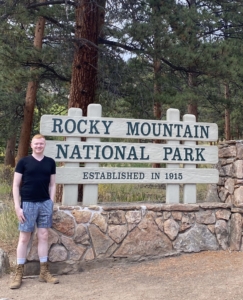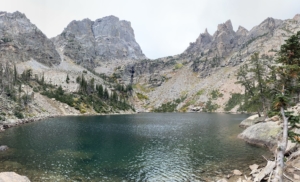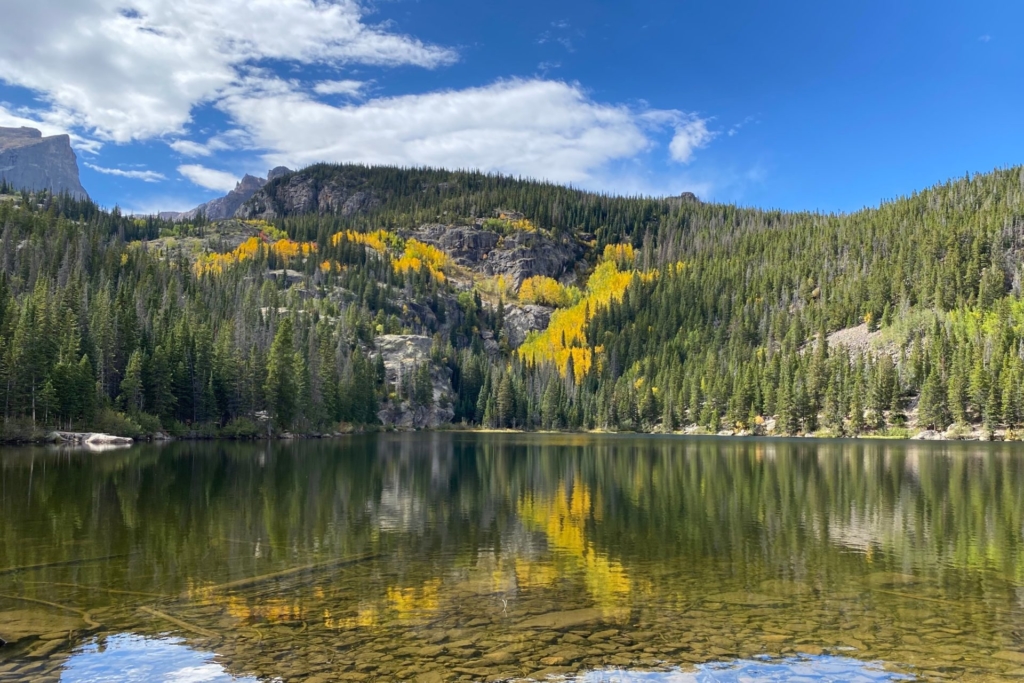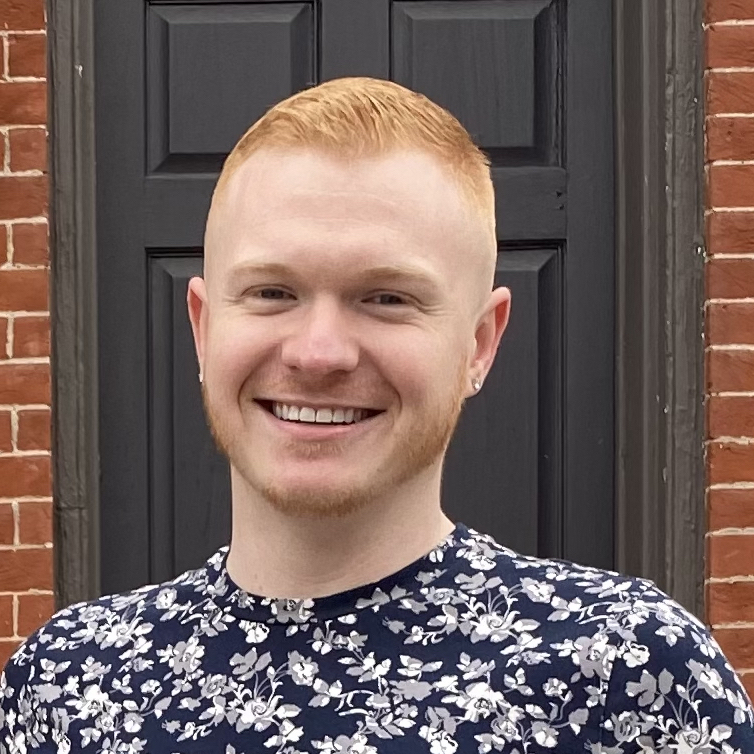Interest makes play of the hardest work.
Enos Mills, Naturalist, Author, and Homesteader

Jason at the entrance of the Rocky Mountain National Park.
Earlier this autumn, I found myself in an environment of deep learning—in, from, and with nature and in community with others. I aim to learn from everything in life but traveling somewhere new reinvigorated my sense of what is possible when you really open yourself up to discovery and learning. The joy and wonder I felt reminded me why learner-centered education is necessary and transformative—it offers the possibility that this uninhibited sense of learning, passion, and creativity can be fostered in everyone from our earliest days.
While in Colorado for Education Reimagine’s Immersive Learning Exchange (ILX) at Embark Education, I made arrangements to arrive a few days early to explore Denver, Boulder, and the Rocky Mountains. Being an enthusiastic but inexperienced hiker, I opted to explore the Rocky Mountains with a tour group.
It wasn’t my initial plan—wanting to embrace the beauty in solitude—but the thought of my Mom receiving a call that I was lost somewhere in the Rockies helped me to choose, albeit begrudgingly, the safer option.
From the moment I started the tour, I knew I was in for a fulfilling day. In a passenger van with a tour guide and six other hikers, we set out on our expedition. Nick, our tour guide from Aspire Tours, shared that the Central Business District of Denver used to be filled with warehouses for regional distribution due to Denver’s expansive rail network with access to many states in the area.

Choose your own adventure—trail marker at Bear Lake.
Before we even arrived at the park, we had the pleasure of seeing two male elk head-butting alongside the road, an indicator of the start of mating season. Their size and our proximity to them was an incredible experience and would not be the last of the day. The elk eventually gave up and peacefully parted ways, one looking a bit comical with a small branch woven between his antlers.
Words and pictures cannot describe the beauty that encompasses the Rocky Mountain National Park. The vastness of the largely untouched land is natural in the most authentic sense. There were also countless opportunities for exploration and learning. I took to describing our tour guide Nick as “Google, but better”—he had a steady stream of observations and connections along the way, truly showing how the flora, fauna, and climate of the Rocky Mountains are interconnected and dependent.
Some of the learnings that stuck with me include:
- The majority of trees in the Rockies are Ponderosa Pines and Trembling Aspens. The Aspens’ leaves change colors at different times of autumn based on their elevation. They can also generate new trees through their own interconnected root system.
- A collection of Aspens in Utah is said to be the largest living organism in the world, with 47,000 genetically identical stems spreading across 106 acres, sharing a collective root system.
- Elk shed their antlers each year. In fact, antlers are characterized by their yearly shedding, whereas horns (like those on goats or sheep) are fixed pieces of bone that do not shed.
- Elk primarily eat grass and leaves, so they are seen at lower elevations in the autumn, following the weather to find grass that has not yet gone dormant for the winter.
- Thunderstorms are common in the mountains in the summer, even if inclement weather is not in the forecast. In short, the sun heats the rocks, which warms the atmosphere. This in turn pulls moisture from the trees and forest floor up, generating clouds and sometimes a full-blown storm.
I could go on for pages, but I’ll leave some of the discovery to you. The connections I felt with nature, myself, and my way of learning have stuck with me in the best way.
It took me going to college and beyond to start exploring which interests of mine made me fundamentally unique.
Jason Krobatsch, Communications Manager at Education Reimagined
Along the hike, I shared with some fellow hikers that anytime I’m out in the woods, I dream about being a park ranger or have regrets that I didn’t major in something like environmental science in college. At the time, I didn’t even know what a career as an environmental scientist might look like.
In truth, I’ve realized that while my formal education prepared me for some aspects of life, it did not equip me to learn deeply about my interests. I could probably still solve a quadratic equation if a million dollars were on the line, but it took me going to college and beyond to start exploring which interests of mine made me fundamentally unique.

The aptly named Emerald Lake.
On the return drive home, Nick passed me a book with a passage marked. He said it reminded him of some of the work I shared that we’re doing at Education Reimagined. Published in 1920, the book is called Trailblazer by Enos Mills, a book that I’m now currently reading in full. Mills is credited as being the “father” of the Rocky Mountain National Park, advocating for its distinction and preservation as a natural space.
This particular chapter of his book focused on the Trail School, the name given to semi-guided adventures he would take children on to learn more about the wonders of nature hidden within the Rockies. He shares that there were no classes, grades, or prizes, just children exploring their inclinations, working together to discover and answer questions that arose.
“These children are in love with their activities. Burroughs has said that knowledge acquired without love will not stick. The most amazing things brought out by the Trail School are the accuracy with which the children see and acquire facts and the correctness with which they describe what they have seen.
It might be thought that our ways of doing things would make the children unsystematic; but when reached by that magnificent incentive called interest the child goes after anything—difficult, easy, pleasant, or otherwise. It is a joy to do it. We found that the children quickly developed the mental habit of being systematic just through interest. It was not long before a child systematically and persistently followed an interest by specializing upon it, thus forming the acquaintance also of the things related to it.”
The benefits of non-industrialized schools and community learning were seen by Mills himself over 100 years ago! He also notes, upon seeing the kids engaged in natural exploration and discovery, “Interest is the master teacher.”
In the following days, as I participated in the ILX—engaging with the passionate educators and thriving learners at Embark Education—I thought back to everything that captured my interest during my day of hiking.
These young learners were so curious and full of excitement, exploring topics they were interested in and learning from real environments and local businesses—particularly Pinwheel coffee shop and Framework bike shop. Just as the elk moved about the mountains and towns to find nourishment, the young learners moved throughout their neighborhood to acquire different experiences to explore their interests and needs. And, like the Aspens self-generate new trees when the conditions are right, the educators at Embark work purposefully to create opportunities for their young people to learn and thrive in an environment that is right for them.
Throughout my trip, there were endless opportunities to learn—my mind was buzzing with a growing body of questions. But, the driver of all this learning, as Mills points out, was my natural interest. “Interest makes play of the hardest work.”
At times, being a lifelong learner can be overwhelming—there’s just SO much to take interest in and explore. But, the joy and understanding that comes with it is a true gift. It’s part of who I am, but also a mindset that anybody can adopt. To lean into this, I encourage you to go somewhere new and take in what you learn—allowing your interests to guide you. Then, imagine that experience for each one of our young people as a way to learn about the world and discover how their interests can shape a future in which they can authentically thrive.
Special thanks to Michael Soguero, who I shared this experience with over dinner at the ILX and he suggested writing my reflections as an article for Voyager.

